Editorial "Apress"
Se han encontrado 45 Coincidencias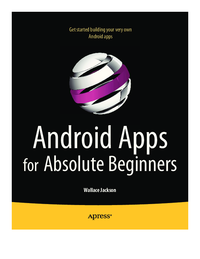
Android Apps for Absolute Beginners
Android Apps
219 Visitas | 1246 Descargas | 2014-02-24 22:08:43 | eancedeg
Manual para principiantes en el desarrollo de aplicaciones para Android. El tema se descompone en 12 capítulos que van desde la introducción del framework sobre el que se va a desarrollar, trabajo con diferentes partes de la API de Android hasta un último capítulo que pretende adelantar que se espera en el futuro de Android.
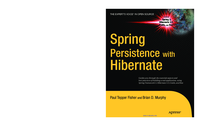
Spring persistence with Hibernate
Spring e Hibernate
57 Visitas | 97 Descargas | 2014-04-28 19:30:07 | javierd
Since its inception, the Spring Framework has gradually changed the rules of application development in the Java community. This book is the ideal guide and teaching companion for developers interested in learning about the Spring Framework and how it can be leveraged to build persistence-driven applications using Hibernate, one of the most popular Java persistence frameworks today. Spring Persistence with Hibernate gets you rolling with fundamental Spring concepts, as well as proven design patterns for integrating persistence into your applications.
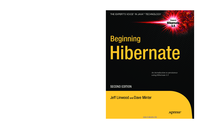
Begining Hibernate 2nd Edition
Hibernate
38 Visitas | 64 Descargas | 2014-04-28 19:33:04 | javierd
Hibernate is an amazing piece of software. With a little experience and the power of annotations, you can build a complex, database-backed system with disturbing ease. Once you have built a system using Hibernate, you will never want to go back to the traditional approaches. While Hibernate is incredibly powerful, it presents a steep learning curve when you first encounter it—steep learning curves are actually a good thing because they impart profound insight once you have scaled them. Yet gaining that insight takes some perseverance and assistance.
Beginning SQL Server 2008 for Developers From Novice to Professional
Administración y Programación en SQL Server 2008
66 Visitas | 102 Descargas | 2014-05-28 18:28:33 | cgarcia
Beginning SQL Server 2008 for Developers is for those who see themselves as becoming developers, database administrators, or a mixture of both but have yet to tread that path with SQL Server 2008. Whether you have no knowledge of databases, have knowledge of desktop databases such as Microsoft Access, or even come from a server-based background such as Oracle, this book will provide you with the insight to get up and running with SQL Server 2008.
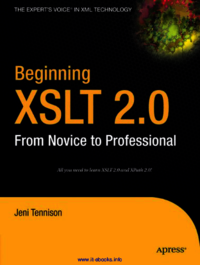
Beginning XSLT 2.0
XML, XSL, XSLT
33 Visitas | 51 Descargas | 2014-11-27 15:37:23 | AMorales
Este seguimiento al comienzo de Jeni Tennison XSLT se ha actualizado para acomodar el estándar XSLT revisado. La primera parte de este libro introduce XML y XSLT a un ritmo cómodo, y demuestra gradualmente técnicas para generar HTML (además de otros formatos), a partir de XML.
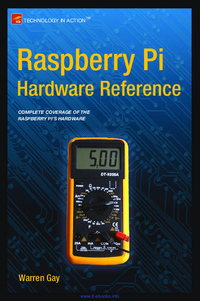
Raspberry Pi Hardware Reference
Raspberry Pi
87 Visitas | 156 Descargas | 2014-12-22 18:47:02 | cbustillo
The Raspberry Pi is deceptively simple. Plug it in, boot it up, and use it as a personal computer, or attach a million gizmos and modules and invent something new and amazing. Either way, what it can actually do is not simple, and you should know exactly what the Raspberry Pi hardware is all about. Raspberry Pi Hardware Reference, from Mastering the Raspberry Pi, is the hardware guide you need on your desk or workbench. Every detail is covered: from power to memory, from the CPU to working with USB. You'll find all the details about working with both wired and wireless Ethernet, SD cards, and the UART interface. The GPIO chapter is invaluable, covering power budgeting, access, and even small but important details like the correct usage of sudo when working with GPIO pins. You'll also find details about the 1-Wire driver, the I2C bus, and the SPI bus. If you need to know anything about your Raspberry Pi's hardware, you will find it here, in Raspberry Pi Hardware Reference.
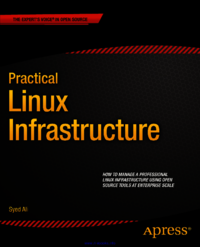
Practical Linux Infrastructure
Linux
70 Visitas | 119 Descargas | 2015-01-12 23:14:29 | cbustillo
Practical Linux Infrastructure teaches you how to use the best open source tools to build a new Linux infrastructure, or alter an existing infrastructure, to ensure it stands up to enterprise-level needs. Each chapter covers a key area of implementation, with clear examples and step-by-step instructions. Using this book, you'll understand why scale matters, and what considerations you need to make. You'll see how to switch to using Google Cloud Platform for your hosted solution, how to use KVM for your virtualization, how to use Git, Postfix, and MySQL for your version control, email, and database, and how to use Puppet for your configuration management. For enterprise-level fault tolerance you'll use Apache, and for load balancing and high availability, you'll use HAProxy and Keepalived. For trend analysis you'll learn how to use Cacti, and for notification you'll use Nagios. You'll also learn how to utilize BIND to implement DNS, how to use DHCP (Dynamic Host Configuration Protocol), and how to setup remote access for your infrastructure using VPN and Iptables. You will finish by looking at the various tools you will need to troubleshoot issues that may occur with your hosted infrastructure. This includes how to use CPU, network, disk and memory management tools such as top, netstat, iostat and vmstat.
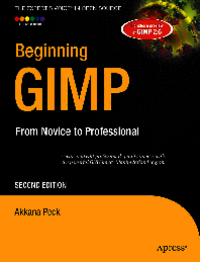
Beginning GIMP from novice to Professional
Diseño
60 Visitas | 100 Descargas | 2015-01-13 16:13:27 | cbustillo
Beginning GIMP: From Novice to Professional is a comprehensive guide to GIMP -- the GNU Image Manipulation Program, the premier free open source image editing program. Loaded with full-color examples, step-by-step instructions and sample projects, it's written to be accessible even to newcomers who have never edited an image before. Find out how to get the most out of that digital camera, and how to prepare digital images for your web site or turn them into posters or greeting cards. Once you're comfortable with the basics, you'll learn how to paint out unwanted objects or paste an object from one photograph into another, and how to draw original icons of your own. Later chapters progress to intermediate and advanced topics such as layer masks, creating brushes and patterns, stitching panoramas, blending modes, image stacking, and writing simple GIMP scripts and plug-ins. The second edition is available now. It discusses some of the changes in GIMP 2.6, and adds some tutorials for more advanced projects such as putting leopard spots on a furry animal or changing the color of a cloudy sky. The first edition is also available. There's a sample chapter available at Apress.com. There's also a download file there containing all of the source code discussed in the book, some sample images in the GIMP's native format (XCF), plus a few other useful scripts which were used to generate some of the figures in the book.
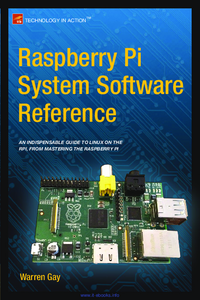
Raspberry Pi System Software Reference
Raspberry Pi
65 Visitas | 136 Descargas | 2015-02-10 15:30:41 | cbustillo
Raspberry Pi is Linux, but it's a unique flavor of Linux, specifically for the ARM-based Pi. Raspberry Pi Software Reference guides you through the boot process, including options for tweaking HDMI, memory, and other boot options. You'll learn the details of run levels and creating new services, and how to use the custom command vcgencmd for doing things like reporting temperature, clock speeds, and voltage. And while there are cross-compilers available for some flavors of Linux, one of the most important things you'll get from Raspberry Pi Software Reference is how to build your own Raspberry Pi cross-compiler on your Mac OSX, Linux, or Windows computer.

Pro AngularJs
AngularJs
97 Visitas | 187 Descargas | 2015-03-23 14:52:49 | javierd
AngularJS is the leading framework for building dynamic JavaScript applications that take advantage of the capabilities of modern browsers and devices. AngularJS, which is maintained by Google, brings the power of the MVC pattern to the client, providing the foundation for complex and rich web apps. It allows you to build applications that are smaller, faster, and with a lighter resource footprint than ever before. Best-selling author Adam Freeman explains how to get the most from AngularJS. He begins by describing the MVC pattern and the many benefits that can be gained from separating your logic and presentation code. He then shows how you can use AngularJS's features within in your projects to produce professional-quality results. Starting from the nuts-and-bolts and building up to the most advanced and sophisticated features AngularJS is carefully unwrapped, going in-depth to give you the knowledge you need.
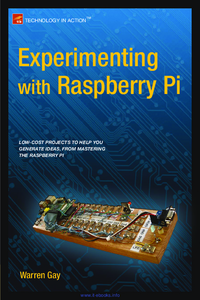
Experimenting with Raspberry Pi
Raspberry Pi
64 Visitas | 142 Descargas | 2015-04-02 15:46:24 | cbustillo
Need some inspiration for your Raspberry Pi projects? Wondering how to work with Wii nunchucks, stepper motors, how to create a remote control panel? If you need guidance, Experimenting with Raspberry Pi is your own personal idea generator. Experimenting with Raspberry Pi covers how to work with various components and hardware like humidity and temperature sensors, Wii nunchucks, GPIO extenders, and IR receivers so you can add these to your own projects. Written with budgets in mind, author Warren Gay encourages you to build, experiment, and swap out various parts to learn more about the Pi and come up with the best ideas and instructions for your own amazing Raspberry Pi project ideas.
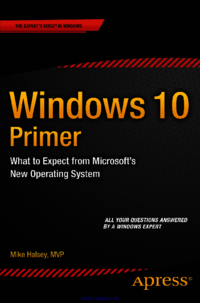
Windows 10 Primer
Windows
138 Visitas | 201 Descargas | 2015-04-17 12:09:40 | cbustillo
With Windows 10 arriving later in 2015, many questions remain to be answered, both for businesses and home users. Will it provide the compatibility of Windows XP, and the usability of Windows 7? Will it banish forever the problems associated with Windows 8? In this book, Windows expert, author and MVP Mike Halsey answers the questions you have and details hidden and improved features that can revolutionize your security, productivity and user experience. Whether you're an IT professional considering or planning an upgrade to your company's PCs or a Windows enthusiast eager to find out if Microsoft has finally built a truly modern Windows experience, Windows 10 Primer has the answers to all your most important questions.
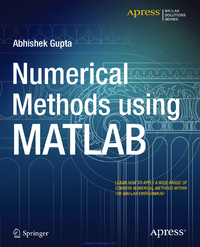
Numerical Methods using MATLAB
Matlab
127 Visitas | 214 Descargas | 2015-04-17 12:11:04 | cbustillo
Numerical Methods with MATLAB provides a highly-practical reference work to assist anyone working with numerical methods. A wide range of techniques are introduced, their merits discussed and fully working MATLAB code samples supplied to demonstrate how they can be coded and applied. Numerical methods have wide applicability across many scientific, mathematical, and engineering disciplines and are most often employed in situations where working out an exact answer to the problem by another method is impractical. Numerical Methods with MATLAB presents each topic in a concise and readable format to help you learn fast and effectively. It is not intended to be a reference work to the conceptual theory that underpins the numerical methods themselves. A wide range of reference works are readily available to supply this information. If, however, you want assistance in applying numerical methods then this is the book for you.
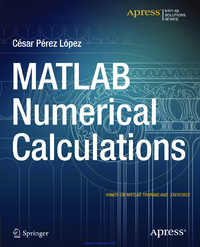
MATLAB Numerical Calculations
Matlab
95 Visitas | 175 Descargas | 2015-04-17 12:12:07 | cbustillo
MATLAB Numerical Calculations focuses on MATLAB capabilities to give you numerical solutions to problems you are likely to encounter in your professional or scholastic life. It introduces you to the MATLAB language with practical hands-on instructions and results, allowing you to quickly achieve your goals. Starting with a look at basic MATLAB functionality with integers, rational numbers and real and complex numbers, and MATLAB's relationship with Maple, you will learn how to solve equations in MATLAB, and how to simplify the results. You will see how MATLAB incorporates vector, matrix and character variables, and functions thereof. MATLAB is a powerful tool used to defined, manipulate and simplify complex algebraic expressions. With MATLAB you can also work with ease in matrix algebra, making use of commands which allow you to find eigenvalues, eigenvectors, determinants, norms and various matrix decompositions, among many other features. Lastly, you will see how you can write scripts and use MATLAB to explore numerical analysis, finding approximations of integrals, derivatives and numerical solutions of differential equations.
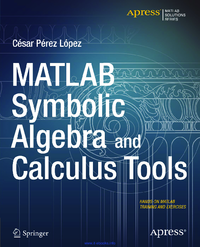
MATLAB Symbolic Algebra and Calculus Tools
MATLAB
96 Visitas | 178 Descargas | 2015-04-23 12:56:52 | cbustillo
MATLAB is a high-level language and environment for numerical computation, visualization, and programming. Using MATLAB, you can analyze data, develop algorithms, and create models and applications. The language, tools, and built-in math functions enable you to explore multiple approaches and reach a solution faster than with spreadsheets or traditional programming languages, such as C/C++ or Java. MATLAB Symbolic Algebra and Calculus Tools introduces you to the MATLAB language with practical hands-on instructions and results, allowing you to quickly achieve your goals. Starting with a look at symbolic variables and functions, you will learn how to solve equations in MATLAB, both symbolically and numerically, and how to simplify the results. Extensive coverage of polynomial solutions, inequalities and systems of equations are covered in detail. You will see how MATLAB incorporates vector, matrix and character variables, and functions thereof. MATLAB is a powerful symbolic manipulator which enables you to factorize, expand and simplify complex algebraic expressions over all common fields (including over finite fields and algebraic field extensions of the rational numbers).
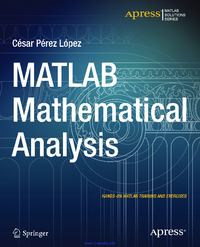
MATLAB Mathematical Analysis
Matlab
107 Visitas | 176 Descargas | 2015-04-23 12:58:47 | cbustillo
MATLAB Mathematical Analysis is a reference book that presents the techniques of mathematical analysis through examples and exercises resolved with MATLAB software. The purpose is to give you examples of the mathematical analysis functions offered by MATLAB so that you can use them in your daily work regardless of the application. The book supposes proper training in the mathematics and so presents the basic knowledge required to be able to use MATLAB for calculational or symbolic solutions to your problems for a vast amount of MATLAB functions. The book begins by introducing the reader to the use of numbers, operators, variables and functions in the MATLAB environment. Then it delves into working with complex variables. A large section is devoted to working with and developing graphical representations of curves, surfaces and volumes. MATLAB functions allow working with two-dimensional and three-dimensional graphics, statistical graphs, curves and surfaces in explicit, implicit, parametric and polar coordinates. Additional work implements twisted curves, surfaces, meshes, contours, volumes and graphical interpolation.
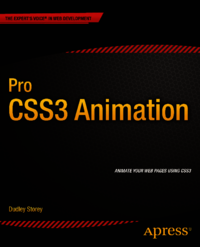
Pro CSS3 Animation
55 Visitas | 88 Descargas | 2015-10-05 15:50:48 | javierd
This book teaches you how to use the full power of CSS to bring your web content to life with interactivity and a fresh visual approach. In the chapters that follow, you’ll learn how to use cutting-edge industry standards to increase the visual appeal, accessibility, and popularity of your site.
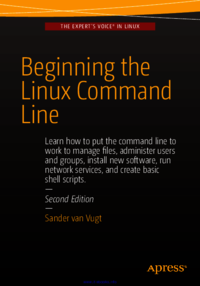
Beginning the Linux Command Line
Linux
54 Visitas | 81 Descargas | 2015-12-03 23:27:13 | cbustillo
This is Linux for those of us who don't mind typing. All Linux users and administrators tend to like the flexibility and speed of Linux administration from the command line in byte–sized chunks, instead of fairly standard graphical user interfaces. Beginning the Linux Command Line is verified against all of the most important Linux distributions, and follows a task–oriented approach which is distribution agnostic. Now this 2nd Edition of Beginning the Linux Command Line updates to the very latest versions of the Linux Operating System, including the new Btrfs file system and its management, and systemd boot procedure and firewall management with firewalld!
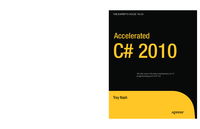
Accelerated C Sharp 2010
40 Visitas | 62 Descargas | 2016-12-12 18:54:56 | stescobedo
Visual C# .NET (C#) is relatively easy to learn for anyone familiar with another object-oriented language. Even someone familiar with Visual Basic 6.0, who is looking for an object-oriented language, will find C# easy to pick up. However, though C#, coupled with the .NET Framework, provides a quick path for creating simple applications, you still must know a wealth of information and understand how to use it correctly in order to produce sophisticated, robust, fault-tolerant C# applications. I teach you what you need to know and explain how best to use your knowledge so that you can quickly develop true C# expertise. Idioms and design patterns are invaluable for developing and applying expertise, and I show you how to use many of them to create applications that are efficient, robust, fault-tolerant, and exceptionsafe. Although many are familiar to C++ and Java programmers, some are unique to .NET and its Common Language Runtime (CLR). I show you how to apply these indispensable idioms and design techniques to seamlessly integrate your C# applications with the .NET runtime, focusing on the new capabilities of C# 3.0
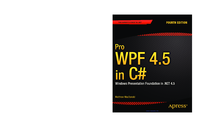
Pro WPF 4.5 in C#
34 Visitas | 65 Descargas | 2016-12-12 19:01:47 | stescobedo
The Windows Presentation Foundation (WPF) is a modern graphical display system for Windows. It’s a radical change from the technologies that came before it, with innovative features such as built-in hardware acceleration and resolution independence, both of which you’ll explore in this chapter. WPF is the best toolkit to use if you want to build a rich desktop application that runs on Windows Vista, Windows 7, and Windows 8 in desktop mode (as well as the corresponding versions of Windows Server). In fact, it’s the only general-purpose toolkit that targets these versions of Windows. By comparison, Microsoft’s new Metro toolkit—although exciting—is limited to Windows 8 systems only. (WPF applications can even be made to run on ancient Windows XP computers, which are still found in many businesses. The only limitation is that you must configure Visual Studio to target the slightly older .NET 4.0 Framework, rather than .NET 4.5.) In this book, you’ll take your first look at the architecture of WPF. You’ll learn how it deals with varying screen resolutions, and you’ll get a high-level survey of its core assemblies and classes. You’ll also consider how WPF has evolved from its initial release to version 4.5
Contribuir
Usted puede contribuir con Libros UCLV, es importante para nosotros su aporte..
Contribuir